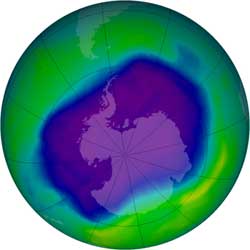Ozone hole is the largest and deepest ever recorded
Ozone hole is the largest and deepest ever recorded
mongabay.com
October 19, 2006
NASA and National Oceanic and Atmospheric Administration scientists that this year’s Antarctic ozone hole is the largest and deepest ever recorded.
“From September 21 to 30, the average area of the ozone hole was the largest ever observed, at 10.6 million square miles,” said Paul Newman, atmospheric scientist at NASA’s Goddard Space Flight Center in Greenbelt, Maryland.
At the same time, scientists from the NOAA’s Earth System Research Laboratory in Boulder, Colo., found that nearly all of the ozone in the layer between eight and 13 miles above the Earth’s surface has been destroyed.
“The ozone is virtually gone in this layer of the atmosphere,” said David Hofmann, director of the Global Monitoring Division at the NOAA Earth System Research Laboratory. “The depleted layer has an unusual vertical extent this year, so it appears that the 2006 ozone hole will go down as a record-setter.”
 From September 21-30, 2006 the average area of the ozone hole was the largest ever observed, at 10.6 million square miles. This image, from Sept. 24, the Antarctic ozone hole was equal to the record single-day largest area of 11.4 million square miles, reached on Sept. 9, 2000. Satellite instruments monitor the ozone layer, and we use their data to create the images that depict the amount of ozone. The blue and purple colors are where there is the least ozone, and the greens, yellows, and reds are where there is more ozone. Credit: NASA
|
“We now have the largest ozone hole on record,” confirmed Craig Long from NOAA’s National Centers for Environmental Prediction
The ozone hole results from the “catalytic destruction” of ozone by atomic chlorine and bromine, the source of which is primarily chlorofluorocarbon (CFC) compounds known as “freons” and bromofluorocarbon compounds known as Halons. In 1987, following the discovery that these compounds were responsible for the ozone depletion in the upper atmosphere, the international community adopted the Montreal Protocol which banned the production of CFCs and halons as well as related ozone depleting chemicals.
The hole in the ozone layer has been forming on a seasonal basis over Antarctic since the mid-1980s. Generally the hole is largest around late September.
Because the ozone layer prevents most harmful UVB wavelengths of ultraviolet light from entering the Earth’s atmosphere, ozone depletion is a significant concern. Increased penetration by UVB wavelengths of ultraviolet light is believed to heighten the incidence of skin cancer, damage plants, and reduce ocean plankton populations.
Scientists from NASA and other agencies believe that the ozone hole over the Antarctic will recover around 2068, nearly 20 years later than estimated in the late 1990s.
This article in based on a news release from NASA